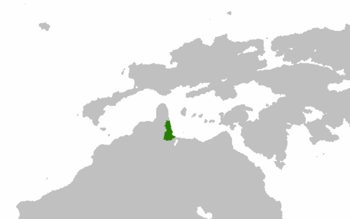Limonaia: Difference between revisions
Jump to navigation
Jump to search
No edit summary |
No edit summary |
||
| Line 73: | Line 73: | ||
|calling_code = +47 | |calling_code = +47 | ||
}} | }} | ||
'''Limonaia''', officially | '''Limonaia''', officially the Grand Duchy of Limonaia (Cristinese: Granducato di Limonaia) is a country in Northern [[Alharu]]. Located next to the Ygros sea, and Sakspati sea, Limonaia shares land borders with [[Soreana]] and a maritime border with [[Valacia]]. Limonaia covers an area of 80,994 km2 (31,271.9 sq mi) and has a largely temperate seasonal and Mediterranean climate. With around 48 million inhabitants, it is the second-most populous, and most densely populated country in Alharu. | ||
It's geographical position in the middle of the Alhargic seas made it an attractive area for the settlement of various early civilisations including the Vamekel who inhabitied the northern areas of modern day Limonaia | |||
==Geography== | ==Geography== | ||
WIP | WIP | ||
Revision as of 12:12, 12 March 2019
The Grand Duchy of Limonaia Il Granducato di Limonaia | |
|---|---|
| Motto: "Nobiscum Deus" "God with us" | |
| Anthem: Alzati, figli della Limonaia! (Arise, Children of Limonaia) | |
 Limonaia in Northern Alharu | |
| Capital and largest city | Limone |
| Official languages | Cristinese |
| Recognised national languages | Variot |
| Ethnic groups (2017) | Limonaians (96,3%) Variotans (1,7%) Other (2%) |
| Demonym(s) | Limonaian |
| Government | Semi-Constitutional Parliamentary Unitary Monarchy |
• Grand Duchess | Margherita Desiderata I |
• Prime Minister | Giuliano Saleri |
| Formation | |
• Establishment of first Republics | March 1489 |
• Unifcation into Grand Duchy | 29 July 1694 |
• Elevation to Kingdom | 17 November 1745 |
• Limonaian Civil War | 11 March 1902 |
• Constitutional Monarchy Established | 2 October 1902 |
• Monarchy overthrown Republic Established | 7 July 1952 |
• Monarchy Restored | 10 March 1976 |
• New Constitution | 22 January 1982 |
| Area | |
• Total | 80,994 km2 (31,272 sq mi) |
| Population | |
• 2017 census | 48,102,000 |
• Density | 594/km2 (1,538.5/sq mi) |
| GDP (PPP) | 2017 estimate |
• Total | $1,633.9 billion |
• Per capita | 33,969 |
| GDP (nominal) | 2017 estimate |
• Total | $1,180.5 billion |
• Per capita | 24,541 |
| Gini (2017) | high |
| HDI (2017) | very high |
| Currency | Limonaian Lira (LLR) |
| Time zone | UTC-5 (Alharun Central Time) |
| Date format | dd/mm/yyyy (AD) |
| Driving side | left |
| Calling code | +47 |
| ISO 3166 code | LI |
Limonaia, officially the Grand Duchy of Limonaia (Cristinese: Granducato di Limonaia) is a country in Northern Alharu. Located next to the Ygros sea, and Sakspati sea, Limonaia shares land borders with Soreana and a maritime border with Valacia. Limonaia covers an area of 80,994 km2 (31,271.9 sq mi) and has a largely temperate seasonal and Mediterranean climate. With around 48 million inhabitants, it is the second-most populous, and most densely populated country in Alharu.
It's geographical position in the middle of the Alhargic seas made it an attractive area for the settlement of various early civilisations including the Vamekel who inhabitied the northern areas of modern day Limonaia
Geography
WIP
Government
WIP This template may be deleted.

